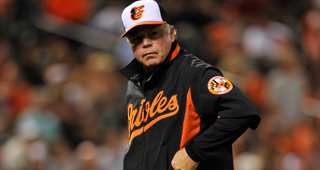There are certainly some reasons to be pessimistic about the Orioles' success so far this season. Starting with the obvious, the Orioles have the worst winning percentage (.583) of all the current division leaders. They also have the smallest lead over the 2nd place team in the division (Blue Jays, 2 games) and the smallest lead over the 3rd place team (Red Sox, 3 games). If you look at Fangraphs’ playoff odds, you’ll see that Baltimore has the worst odds out of any division leader to hold on and win the division (27.8%). No other current division leader has a division opponent with a higher chance of making the playoffs; the Orioles have two, the Blue Jays (34.8%) and the Red Sox (35.7%).
While part of those playoff chances speaks to how up in the air the AL East is, they speak more to how the Orioles got to where they are. Baltimore currently has a +42 run differential, which is 10th in MLB and the worst of the division leaders with the exception of the Rangers, who are only plus +27 have some serious luck/“clutchness” going with their MLB-best 18-7 in one-run games. While the Rangers have the luxury of playing in a division with a team that is drastically underperforming according to their expected win-loss record (the Mariners) and a team that got off to a really slow start and has a lot of ground to make up (the Astros), the same isn’t true for Baltimore. Both of the teams that are nipping at their heels have better run differentials: the Blue Jays are +65 and and the Red Sox are +58.
When you look at the 4.62 runs allowed per game (17th in MLB) and then look at the rotation the Orioles have been trotting out, it’s not exactly surprising and goes a long way to explaining things. But despite the rotation’s problems, the bullpen, which is in third place in MLB by ERA- (73), tied for 4th by ERA (3.20), 5th place by RE24 (24.20) and 2nd place by WPA (5.05), has been absolutely fantastic. Zach Britton and Brad Brach have been two of the best relievers in baseball this season, by WAR, ERA, WHIP and WPA, to name just a few stats. Spice it up with more quality arms with Dylan Bundy, Mychal Givens and Vance Worley, then finish it off with Buck Showalter’s successful management of the bullpen, and you have a recipe for success once they take over. Unsurprisingly, the Orioles are number 8 in MLB in innings pitched by the bullpen. They are the only division leading team to have that many innings pitched in relief, which is certainly a feature rather than a bug, given the quality in the bullpen and the lack of it in the rotation.
The other reason that the rotation hasn’t been able to hurt the Orioles in the standings more is, obviously, their offense. The pitching staff giving up 4.62 runs per game isn’t quite as terrifying when you see that the offense is putting up 5.12 runs per game, good for 5th in MLB. As a team, the Orioles are second in wOBA (.340), tied for 4th in AVG (.271) and perhaps most importantly lead MLB in home runs with 131. Also important is the fact that the team’s OBP is much higher than it was last year at .332 (tied for 7th). When they were 24th in OBP in 2015 (.307) and 3rd in home runs (217), those shots weren’t quite as productive. This year, that uptick in OBP means those dingers count for more a lot of the time and it’s paying dividends for the Orioles’ offense and giving them the runs they need to stay in and win games when their rotation needs help.
Now that we’re over halfway through the season and the trade deadline is a-loomin’, the question is what do the Orioles do now? The obvious answer for the Orioles would be to upgrade the starting pitching. But with a farm that was ranked near the bottom in MLB before the season, it’s not like they can compete with teams like Texas and Boston who are not only contending and could use pitching, but also have the prospect depth to procure the best pitchers available. While they could go after lesser talent, it’s not clear that they have the prospect funds to really upgrade that much considering the cost of pitching these days.
At the end of the day, the Orioles may just have to sit back and hope that the formula that has gotten them to this point continues to produce results. That may be a long shot, what with Tulo back to help a surging Blue Jays’ offense and the Red Sox upgrading their already ridiculous lineup and purportedly lookingintopitching and having the prospects to trade for it. Rather than being pessimistic about the Orioles success going forward, I think the answer is that we should be cautiously, very cautiously, optimistic. The format they’ve put together has been working and even though there are some question marks, there may not be too much to do except to let Showalter manage the hell out the bullpen and pray the dinger well doesn’t dry up until winter has come.



